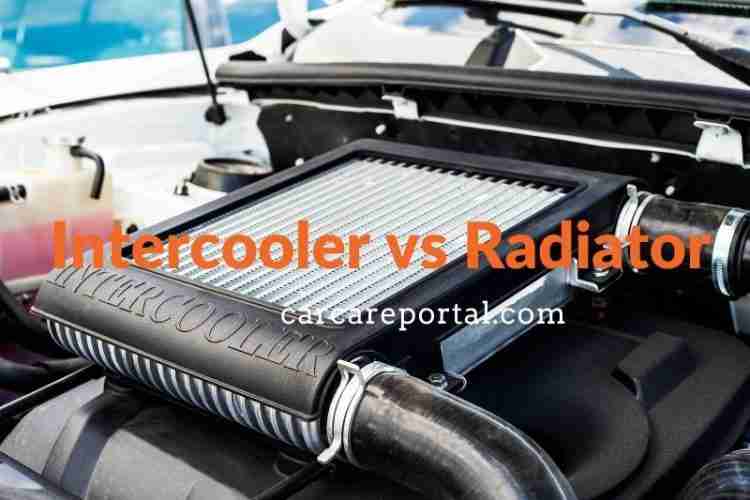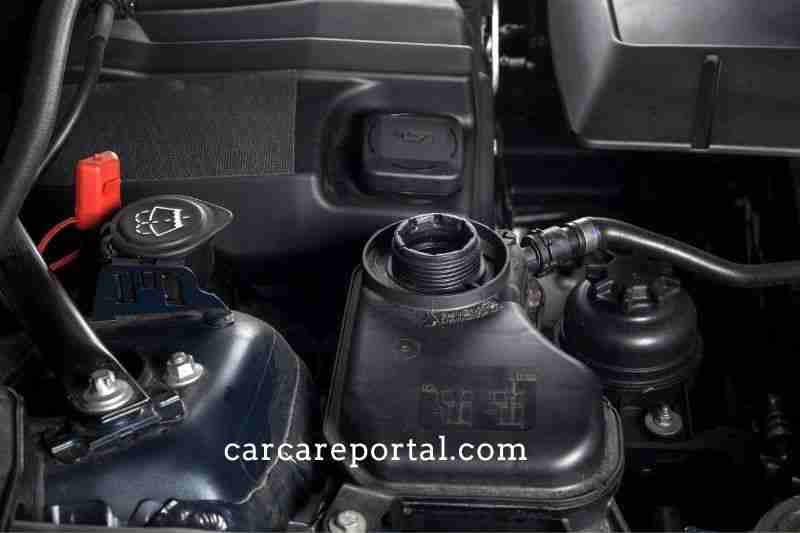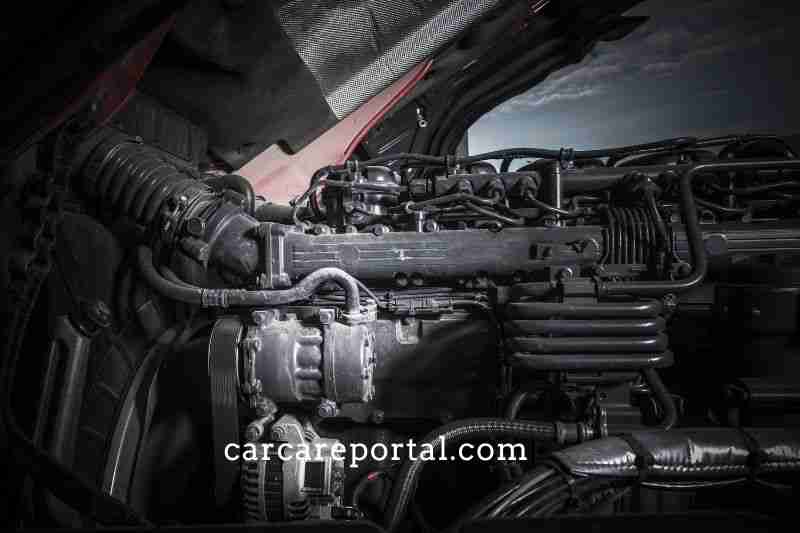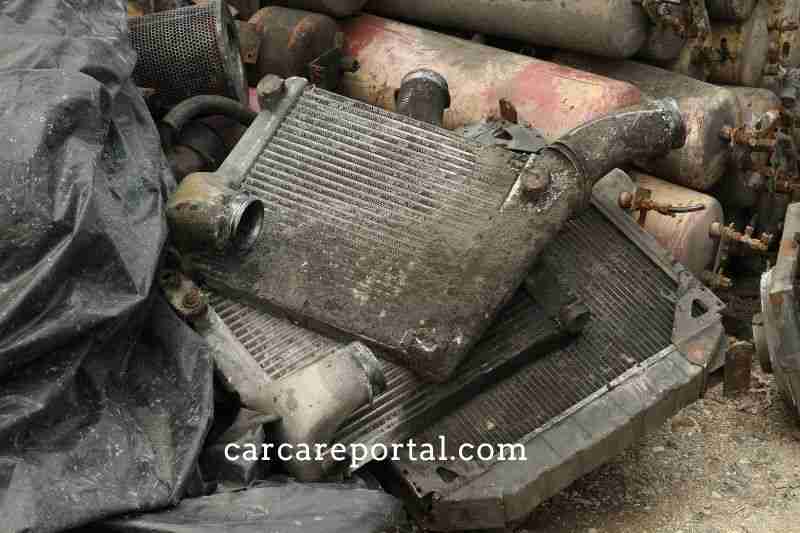What’s The Difference between Intercooler vs Radiator? 2022

Intercooler vs Radiator? What’s the Difference? Intercoolers and radiators both serve to cool fluids, but they work in different ways. An intercooler uses air to cool fluid, while a radiator uses water. Intercoolers are more common in vehicles because they are less likely to leak than radiators.
The Radiator
A radiator transfers heat from the coolant in your car through a heat exchanger. A fan on a radiator may draw air through it to cool it down. This can occur when the vehicle is parked or after the engine has been switched off.
Engines produce a lot of heat when they are running. Your car’s cooling system circulates coolant through your engine. This absorbs heat and then transfers it to the block.
Coolant transfers heat from the engine to the radiator. The radiator cools it by exchanging heat with the surrounding environment and circulating air through it. Radiators made of copper or aluminum are used in many modern automobiles.
The heat transfer from the coolant through these tubes is determined by the temperature difference between coolant and ambient air temperature. Therefore, heat transferred from the coolant to tubes will be less if it drops quickly in temperature.
The Intercooler
An intercooler, which reduces the intake water temperature in forced-induction vehicles, is a component. In that it transfers heat from the intake to the ambient, the intercooler works similarly to a radiator.
On the other hand, an intercooler is an air-to-air heat exchanger. A radiator is a water-to-air heat transfer.
The supercharger or turbocharger compresses the air before reaching the engine’s cylinders. This heat creates heat which makes the air in the engine hotter.
The oxygen concentration in each cylinder drops when the atmospheric temperature rises. This can affect your engine’s efficiency. The oxygen density of compressed cool air is higher, which increases power and efficiency.

What’s the difference between Intercooler vs Radiator?
1. How they work
How does a Radiator Work?
Car radiators work by pushing coolant through thin metal fins (thinner metal fins). This effectively transfers heat from the car to the environment. A fan is used to blow air across radiators in vehicles with fans. This helps remove hot air from the car.
Engines produce a lot of heat when they are in operation. Your vehicle’s cooling system pumps coolant into the engine to prevent overheating. The coolant absorbs heat from the engine and removes it from the block.
Coolant transports heat from your engine to the radiator. The liquid then cools by blowing air through the liquid and exchanging heat with the surrounding atmosphere.
In this heat transfer process, the radiator has several critical components, including the pressure cap, core and outlet tanks.
Many newer vehicles use copper or aluminum radiators. Coolant flows through tubes that are mounted from the inlet to outlet tanks. A tabulator is built into the tubes. This causes an increase in the fluid (coolant) that flows through the tubes.
The heat difference between coolant and tubes determines how much heat is transferred to these tubes by the coolant. If the coolant temperature drops quickly, the heat transfer to the tubes will be lower.
How does Intercooler work?
An intercooler is a device that lowers the intake temperature in intercooler turbo engines using forced induction. This can be done with either a turbocharger or a supercharger.
The primary function of the intercooler is to lower the hot air temperature after it has been compressed by the turbo or supercharger, just before it enters the engine.
Turbochargers compress air, making it denser before reaching your engine cylinders. The engine’s ability to squeeze air into the various pistons will allow it to burn fuel effectively, increasing its power.
This causes the release of heat, which raises the temperature of the engine’s air. As the air temperature rises, it becomes denser and lowers the oxygen content of various cylinders. This can affect your engine’s performance.
This is where the car intercooler steps in. This intercooler helps to stop this process. The cooling of compressed air allows your engine to have enough oxygen. This improves combustion in all cylinders.
It is also essential to understand that the compression temperature can increase the engine’s efficiency, resulting in a higher fuel consumption ratio.
There are two types of intercoolers: air-to-air and water-to-water—the first functions by moving compressed air through small tubes or cooling fins. Your cooling fins transfer the heat from compressed air to your fins. This is done by rapid airflow outside of your vehicle.
Cool compressed air flows through an intercooler to reach the engine manifold, then the cylinders. They are an excellent choice for turbocharged cars because of their simplicity.
Air-to-water intercooler (the latter) cools compressed air using water. Water is pumped through the unit to remove heat from the compressed air. The water temperature rises and goes through the radiator or cooling circuit before returning to the intercooler.
Air-to-water intercoolers are smaller than air-to-air. This makes them ideal for small engines. Water is also a better heat conductor than oxygen, making them suitable for all temperatures. They aren’t common in all vehicle engines.
2. Structure
Intercooler
The cooler is basically a smaller version of a Radiator, but with a more complicated construction. Because the intercooler uses liquid cooling, it will have pipes that can be filled with water. This Radiator is often used for supercharged or turbo-powered engines. The Radiator can be used alone or in conjunction with an intercooler.
Radiator
There are four main components to the Radiator:
- Pressure cap
- Core
- Output
- Inlet tank
Today’s radiators are made of aluminum or copper, making them suitable heat conductor materials. The machine creates pressure as the stream flows through the tubes, increasing the flow pressure to cool down.
Radiators regulate the engine’s temperature to keep it from rising too high. Excessive heat can lead to engine failure and short-circuiting. The radiator ensures the engine is stable and provides the best operating environment.

3. Application
All cooling effects are different for different engine types.
Intercooler
The intercooler cools the turbo using hot compressed air. This then flows to the engine. The cooler cools the turbo air to remove heat when it reaches a specific temperature.
The cooler is usually only used with turbo-powered cars. The radiator and more excellent will be used in this type of engine to maintain a constant temperature. A cooler is required to dissipate heat in high-speed cars continuously.
Radiator
Radiators are found in the majority of cars’ engines. The heatsink works independently of the cooler. The radiator absorbs heat from the engine cylinders and keeps the system cool.
4. Cost
An intercooler will cost about twice as much as a radiator. The intercooler requires more piping and has a larger surface area. Also, the intercooler uses higher quality materials (thicker tubes and fins), which can better handle heat stress and pressure buildup from turbos and superchargers.
An intercooler is lighter than any radiator system because it uses less material. It is important to note that modern heat exchangers can introduce tubes, fins and other exposed materials into the engine bay, which can be subject to corrosion if not correctly treated.
5. Which one should you use?
Each system works excellent for the job it was designed to do. However, you can still see performance improvements when you combine them in a dual-pass setup (where one system cools and the other passes it).
You should only purchase heat exchangers made by a trusted manufacturer such as the cooling experts at CSF to ensure that all claims about cooling efficiency have been independently verified.
If you’re weighing the pros and cons of a radiator or intercooler, it is worth speaking with an expert to determine if better options can be found. Quality radiators and intercoolers can last for years while ensuring your vehicle is ready to go when needed.

FAQs
1. Can an intercooler or radiator be used simultaneously?
In some cases, it is possible to use both the radiator and intercooler simultaneously. It is necessary to have both the radiator and intercooler for turbo-powered cars. A radiator will suffice for another vehicle, while intercoolers can be added if necessary.
The radiator will benefit significantly from the intercooler’s assistance in simultaneous use. This will improve the engine heat dissipation. Pay attention to where the intercooler is placed.
2. Is it possible for an air cooler to be run without a turbo?
The cooler should theoretically be able to work without the turbo. If this condition continues, it can restrict circulation to the engine.
When the timing is correct, the air cooler can only perform at its maximum potential. The turbo presses air into the air, causing it to heat up. It comes with a cooler that lowers the temperature to neutralize. This helps to prevent overheating. The cooler will block air intake if the turbo is not heating up while running.
3. What effect does the radiator have?
Excessive heat is the leading cause of most internal engine failures. Excessive heat can cause internal engine explosions and damage. High temperatures can also melt flakes and weld internal components.
The radiator can therefore be considered an essential part of a car. Radiators can reduce engine overheating and other serious problems.
4. Are All Cars Equipped with Radiators?
All cars have radiators. Most of them do. Air-cooled vehicles use heat instead of water to cool. Radiators transfer heat from one fluid into another. Radiators are used in engines to transfer heat from hot coolants to the air.
A radiator is composed of a series of metal tubes connected by fins. The fins increase the radiator’s surface area, improving heat transfer.
Radiators are typically located at the front of the vehicle to get the most airflow. Some radiators can be found under the hood or in the rear.
5. Can an Intercooler Improve a Car’s Performance?
An intercooler can improve a car’s performance, providing cool air to the engine. The intercooler cools the engine and reduces engine knock and detonation. Intercoolers can also help extend the engine’s life by preventing excessive heat.
6. What do I need to do to upgrade my radiator?
You will need to upgrade the radiator if you plan to add an aftermarket intercooler. The intercooler will heat the coolant more, so the radiator must be capable of handling this heat load.
You will need to consider your engine’s size and power requirements when upgrading your radiator. You should consult a specialist mechanic to ensure the best radiator fit for your vehicle.
Bottom line
Both devices cool the engine by circulating air or fluids. Both devices work similarly. You can install either one on your vehicle, but it won’t affect the overall functioning of your vehicle.
It all comes down to what your car needs are. An intercooler is more beneficial for cars with turbocharged engines. They provide faster airflow and heat reduction. Radiators, however, are great for vehicles that are not used daily.
Read also:













No Comment